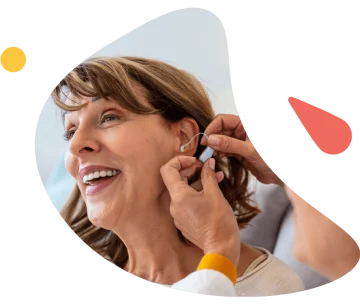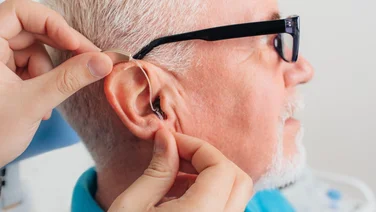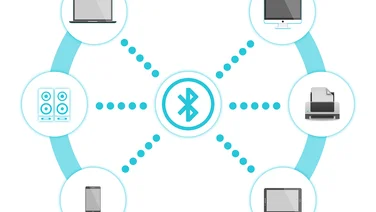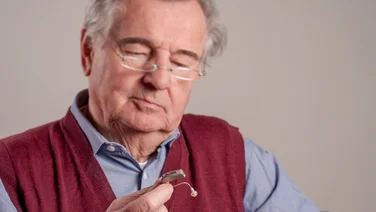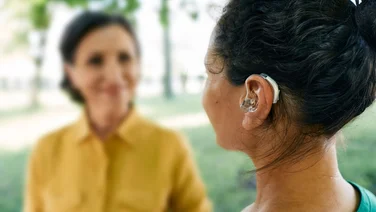When we talk about hearing aids, most people probably think of a curved, plastic case that hooks over the top of and behind the ear. These are behind-the-ear (BTE) hearing aids.
We explain how BTE hearing aids work, their advantages and drawbacks, and who might benefit from wearing one.If you feel that your hearing may be deteriorating, it’s always worth speaking to a professional. We can connect you with a local audiologist to get you the help you need. Fill in our quick form and we’ll do the rest.
How do BTE hearing aids work?
All hearing aids are made up of three main components: a microphone, an amplifier, and a speaker (also called a receiver).
With a BTE hearing aid, the microphone and amplifier are contained in a small, plastic case that hooks over and rests behind the ear.
The microphone picks up sounds from the environment and converts them into electrical signals. The amplifier then processes these signals to make them louder.
The case, which is attached to a thin, flexible tubing and a custom-made earmold, then carries the signals to the receiver and into the ear.

Behind-the-ear (BTE) vs receiver in canal (RIC)
BTE hearing aids are connected to an earmold. The earmold fits in the concha or bowl of your outer ear, so it is visible. The receiver is inside the case, behind the ear.
RIC (receiver in the canal) hearing aids are connected to a small, flexible, bell-shaped tip (a dome) that covers the receiver. The dome is pushed into your ear canal, so you cannot see it. RIC hearing aids with domes don’t block the ear canal like BTE hearing aids, so they allow you to hear sounds more naturally.
As a result, RIC aids may be suitable for people with mild or severe hearing loss who can pick up low-pitched sounds. It also allows you to hear your own voice more naturally.
BTE hearing aids with earmolds are suitable for people with very severe or profound hearing loss. Hearing aids for severe to profound hearing loss are called ‘power’ or ‘superpower’ hearing aids.
Experiencing hearing loss and think a hearing aid might help?
Talk to your audiologist about what type of hearing aid is best for you.
Pros and cons of BTE hearing aids
Behind-the-ear hearing aids are the most common type of hearing aids because they are suitable for most types of hearing loss, from mild to profound. We look at the advantages and drawbacks below:
- They are larger than in the ear hearing aids, so they are often available with more advanced features, like bluetooth technology
- They are less fiddly than other hearing aid styles. That means you can use them more easily if you have a vision impairment or problems with your dexterity
- Many types come with rechargeable batteries, so you don’t have to worry about buying new batteries frequently. And the batteries are larger, so they tend to last longer
- Earmolds for BTE hearing aids are custom-made to fit your ear size and shape, making them particularly suitable for children, who will need to have new earmolds as they grow
- Because the electronic components don’t go into your ear, they are less prone to dirt and wax, so they’re easier to keep clean
- Many BTE hearing aids are small and discreet, tucking in behind your ear so they’re hardly noticeable
- They block the entrance to the ear canal so they can make you feel like your ears are plugged
- The casing tucks behind the back of your ear so you might find them uncomfortable if you also wear glasses
- BTE hearing aids can sometimes pick up more background sound – like wind noise
How much do BTE hearing aids cost?
The cost of a BTE hearing aid will depend on several factors, including the brand, the features it includes, and how advanced its technology is.
You will also need to factor in the cost of having the earmold custom-made to ensure a comfortable fit, adjustments, batteries, and ongoing maintenance. However, in some private clinics, the aftercare and earmolds are included in the price.
In the US, you may be able to get some hearing aids for as little as $1,000, but you can pay as much as $4,000. The average cost is around $2,000 to $3,000 per hearing aid.
In the UK, you can get some hearing aids for around £800, but most people spend between £1,800 and £3,100.
It’s a good idea to discuss hearing aid choices with your audiologist, who will advise you about the type of hearing aid that is right for you.
Book a hearing consultation for free today
